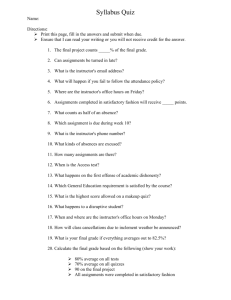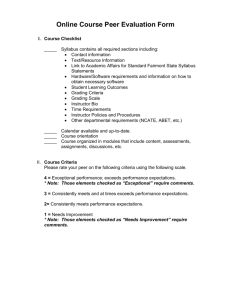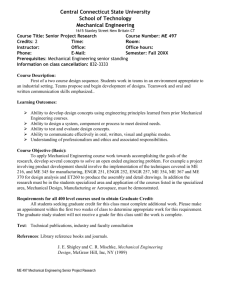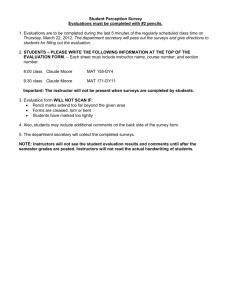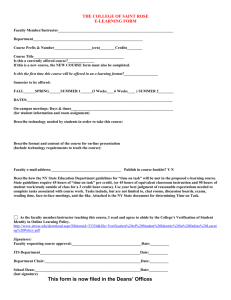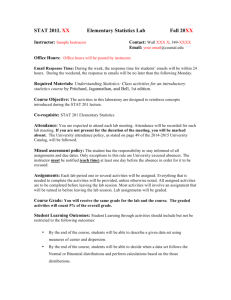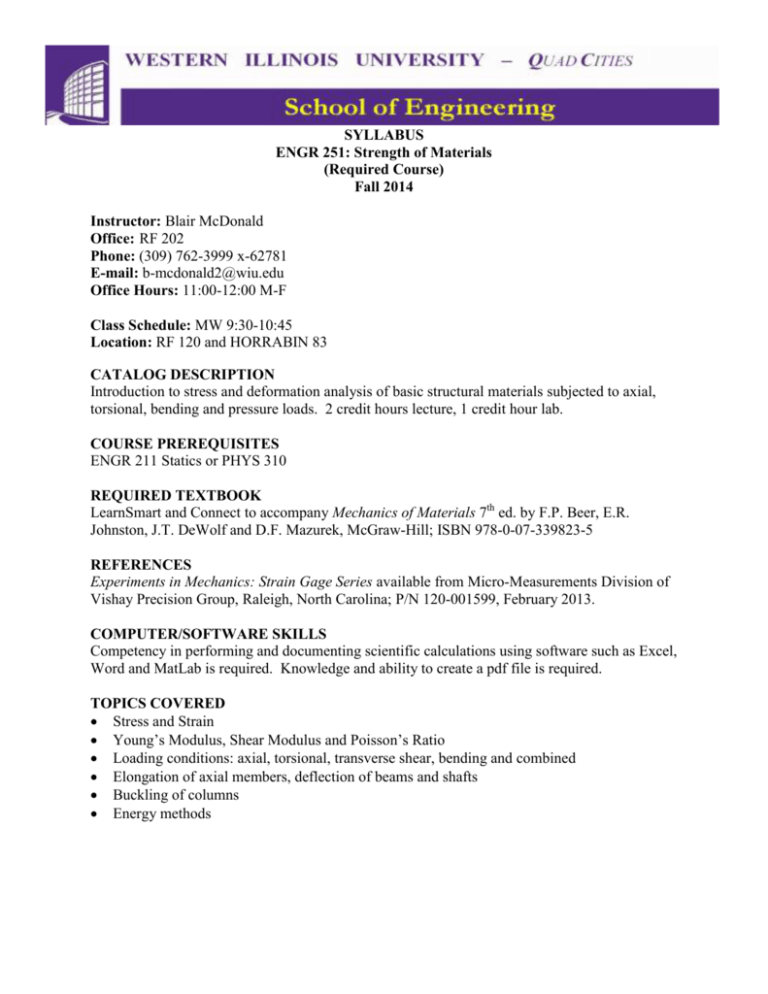
SYLLABUS
ENGR 251: Strength of Materials
(Required Course)
Fall 2014
Instructor: Blair McDonald
Office: RF 202
Phone: (309) 762-3999 x-62781
E-mail: b-mcdonald2@wiu.edu
Office Hours: 11:00-12:00 M-F
Class Schedule: MW 9:30-10:45
Location: RF 120 and HORRABIN 83
CATALOG DESCRIPTION
Introduction to stress and deformation analysis of basic structural materials subjected to axial,
torsional, bending and pressure loads. 2 credit hours lecture, 1 credit hour lab.
COURSE PREREQUISITES
ENGR 211 Statics or PHYS 310
REQUIRED TEXTBOOK
LearnSmart and Connect to accompany Mechanics of Materials 7th ed. by F.P. Beer, E.R.
Johnston, J.T. DeWolf and D.F. Mazurek, McGraw-Hill; ISBN 978-0-07-339823-5
REFERENCES
Experiments in Mechanics: Strain Gage Series available from Micro-Measurements Division of
Vishay Precision Group, Raleigh, North Carolina; P/N 120-001599, February 2013.
COMPUTER/SOFTWARE SKILLS
Competency in performing and documenting scientific calculations using software such as Excel,
Word and MatLab is required. Knowledge and ability to create a pdf file is required.
TOPICS COVERED
Stress and Strain
Young’s Modulus, Shear Modulus and Poisson’s Ratio
Loading conditions: axial, torsional, transverse shear, bending and combined
Elongation of axial members, deflection of beams and shafts
Buckling of columns
Energy methods
COURSE LEARNING OBJECTIVES AND RELATIONSHIP TO PROGRAM
OUTCOMES (ABET Criteria 3a-3k)
ABET Criteria 3:
Outcome-Related Course Learning Objectives
a
b
c
d
e
Compute stress, strain and deformation in an axial member
X
X
X
Compute direct shear stresses
Compute bending stresses
Compute torsional shear stresses
Compute the state of stress at a point in a loaded beam
Determine stress concentration factors
Determine the stress on a plane given the state of stress
Compute column critical load and stress
Compute the deflection of beams and shafts
Prepare well documented problem solutions
Utilize modern computational tools in analysis and solutions
X
X
X
X
X
X
X
X
X
X
X
X
X
X
X
X
X
X
X
X
X
X
X
X
f
g
h
i
j
k
X
X
Criterion 3a: an ability to apply knowledge of mathematics, science, and engineering
Criterion 3b: an ability to design and conduct experiments, as well as to analyze and interpret data
Criterion 3c: an ability to design a system, component, or process to meet desired needs
Criterion 3d: an ability to function on multidisciplinary teams
Criterion 3e: an ability to identify, formulate, and solve engineering problems
Criterion 3f: an understanding of professional and ethical responsibility
Criterion 3g: an ability to communicate effectively
Criterion 3h: the broad education necessary to understand the impact of engineering solutions in a global and societal context
Criterion 3i: a recognition of the need for, and an ability to engage in life-long learning
Criterion 3j: a knowledge of contemporary issues
Criterion 3k: an ability to use the techniques, skills, and modern engineering tools necessary for engineering practice
CONTRIBUTION OF COURSE TO PROFESSIONAL COMPONENT
This course contributes to the engineering science component of the Engineering curriculum.
Prepared by: Blair McDonald
Date: 8/15/2014
2
DISCLAIMER STATEMENT
All information contained in this syllabus, other than the grading, late assignment and attendance
policies, may be subject to change with advance notice, as deemed appropriate by the instructor.
COURSE POLICIES
Attendance
Students are expected to regularly attend class. When absent, they are responsible for
notes, homework assignments, lab assignments, projects, exams and quizzes. Discuss
medical or family emergencies with the instructor as soon as possible (preferably before
missing due dates for assignments and exams) to make accommodations. Non-attending
students are not automatically dropped, any student enrolled beyond the final withdrawal
date but not attending will receive a final grade of F.
Late Work
Late work will not typically be accepted; if accepted, it will be for no more than 2/3 of
the graded value. No work will be accepted a week after the due date.
Electronic Devices
Cell phones and all other forms of electronic communication devices, if carried into the
classroom, must be turned off. The use of computers and other electronic devices during
class is restricted to classroom activities and course applications. Do not record lecture
materials without obtaining prior written consent of the instructor.
Exam Content
All quizzes and the final exam will be comprehensive. Quizzes will typically involve
solving a single problem similar to recent homework or lecture material during the final
10 minutes (or less) of class.
Laboratory Work
Courses that include laboratory work (especially when done in groups) may require
scheduling time outside of the regular class periods to accommodate supervision, utilize
equipment and have sufficient time to accomplish the assigned procedures. Always
obtain training prior to using any tool, chemical or equipment and never work alone in a
laboratory setting. Obtain and wear protective clothing and equipment. Stay safe. No
horseplay will be tolerated.
Grammar, Legibility and Form
All work submitted must be legible and grammatically correct. Work not conforming to
acceptable formats, standards and English will not be graded.
Course Grade
Student letter grades will be based on the assessment of reading, practice problems, lab
work, term projects, quizzes (announced and unannounced), and a final exam. The weight
for the final exam is 40%, 15% for quizzes, 10% for written problems, 20% for Connects,
5% for reading (LearnSmart), and 10% for lab reports.
Grading Scale:
A
A-
93% - 100%
90%-92.9%
B+
B
B-
C+
C
C-
87%-89.9%
83%-86.9%
80%-82.9%
3
77%-79.9%
73%-76.9%
70%-72.9%
D
F
60%-69.9%
<60%
READING AND HOMEWORK
In order to fully accomplish the course outcomes, it is imperative that students focus on and
develop sound problem solving skills and a broad understanding of the methods used in
professional engineering practice. Reading the text and working problems are essential to
learning course materials and developing professional engineering skills. In keeping with this, it
is essential that students do all problems on their own. It is valuable to discuss problems in a
study group or with a friend. However, each student must be able to prepare problem solutions
submitted as their work on their own. The use of a solution manual is not allowed, all work
turned in MUST be the student’s own work. Work that appears to be copied from a solution
manual will not be graded. Most assigned work will be submitted electronically using
WesternOnLine (WoL), Connect or LearnSmart; scanned work must be legible. The general
policies for WIU students are available online at http://www.wiu.edu/provost/students.php.
GENERAL GUIDELINES
If you are encountering difficulties with the course, please see the instructor.
Utilize the instructor’s office hours.
Read assigned material and review example problems prior to attending class/lab.
Plan on spending at least 3 hours outside of class per lecture hour working on assigned
problems. Do not wait until the last day to start working on your homework or prepare
for an exam.
There will be no make-up exams – exceptions: school activities and medical excuses.
ACADEMIC INTEGRITY POLICY
Academic dishonesty will not be tolerated and will be prosecuted to the fullest extent. You are
expected to have read and understood the current issue of the student handbook regarding student
responsibilities and rights, policy information about procedures and what constitutes acceptable
on-campus behavior. See www.wiu.edu/policies/acintegrity.php for more information. Everyone
is expected to complete their own assignments. Engineering students are expected to maintain
high standards of ethical behavior. Plagiarism: using a solution manual to complete assigned
work is plagiarism.
AMERICANS WITH DISABILITIES ACT
In accordance with University policy and the Americans with Disabilities Act (ADA), academic
accommodations may be made for any student who notifies the instructor of the need for an
accommodation. For the instructor to provide the proper accommodation(s) you must
obtaindocumentation of the need for an accommodation through Disability Support Services and
provide it to the instructor. It is imperative that the disabled student take the initiative to bring
such needs to the instructor’s attention, as he/she is not legally permitted to inquire about a
disability. Students who may require special assistance in emergency evacuations (i.e. fire,
tornado, etc.) should contact the instructor as to the most appropriate procedures to follow in
such an emergency. Contact Disability Support Services at 309-298-2512 for additional
information.
4
COURSE OUTLINE
Lec Date
1 25-Aug
2 27-Aug
1-Sep
3 3-Sep
4 8-Sep
5 10-Sep
6 15-Sep
7 17-Sep
8 22-Sep
9 24-Sep
10 29-Sep
11 1-Oct
12 6-Oct
13 8-Oct
14 13-Oct
15 15-Oct
16 20-Oct
17 22-Oct
18 27-Oct
19 29-Oct
20 3-Nov
21 5-Nov
22 10-Nov
23 12-Nov
24 17-Nov
25 19-Nov
24-Nov
26-Nov
26 1-Dec
27 3-Dec
28 8-Dec
29 10-Dec
17-Dec
ENGR 251: Strength of Materials
Topic
Course Introduction
Forces vs Stresses, Failures and FS
Labor Day
Strain, Young's Mod. & Poisson's Ratio
Shear Strain, St. Venant's, Stress Conc.
Torsion; shear stress, indeterminant
Torsion, angle of twist
Shafts: power, stress concentrations
The elastic curve and bending stress
Section def., composite sect., stress conc.
Beams; shear and bending moment diag.
Singularity functions
Shear stress in beams
Shear flow
Transformation of stress and strain
General state of stress
Stresses in thin-walled pres. Vessels
Transformation of strain; strain rosettes
Principal stresses
Stress due to combined loads
Deflection of beams
Singularity and superposition
Moment area theorem
Columns: Eulers Formula
Centric load design
Eccentric load design
Thanksgiving Break
Thanksgiving Break
Energy Methods: strain energy
Single loads
Review
Review
Final Exam; Wednesday 8:00-9:50
Class Meets M,W from 9:30-10:45 in RF 120
Submit HW in [] to WoL prior to lecture.
Read HW
1:1-5
L 1 Lab 01: Resume
2:1-5
1
2
L2
3
L3
4
L4
5
2:6-8,10,11
3:1-2
3:3
3:4-5
4:1-2
4:3-5
5:1-3
5:4
6:1
6:3, 4
7:1-2
7:3-4
7:6
7:7-9
8:1,2
8:3
9:1-2
9:3-4
9:5
10:1
10:3
10:4
11:1-3
11:5
1:7,11,19,31,38,61,65,[9]
2:12,14,19,22,[35],41
Lab 02: Tension Testing
2:47,58,[61],66,126,130,131; 3:15,21,32
Lab 03: Torsion Testing
3:35,41,[58],64,76,81,87,153
Lab 04: Bending Test for Mod of Elasticity, E-101
4:1,7,8,9,41,52,62,[192]
6 5:[11],12,18,[22],55,69,87,159
L 5 Lab 05: Poisson's Ratio, E-102
7 6:3,5,7,8,33,96,[97]
8 7:[1 through 16],20,23,29
L 6 Lab 06: Principle Stresses, E-103
9 7:[55],79,87,120,146,162
10 8:8,15,36,[39],65,69
L 7 Lab 7: Stress Concentration Factor, E-104
11 9:[1,2,3 and 4],10,31,46,53,77,81,92
12 9:[95,96,97,120],129; 10:13,24,27
L 8 Lab 8: V and P From Measured Strain, E-105
13 10:[1,6],30,71,78,113,[119]
14 11:1,4,5,9,18,73,[104],124
Homework Assignments
ENGR 251: Strength of Materials
Fall 2014
Instructor: Blair McDonald
Office: RF 202
Phone: (309) 762-3999 x-62781
E-mail: b-mcdonald2@wiu.edu
Office Hours: 11:00-12:00 M-F
Class Schedule: MW 9:30-10:45
Location: RF 120 and HORRABIN 83
The homework in this course involves working problems related to solid mechanics. Each
problem is developed and selected to focus on a particular principle or topic. Working these
problems provides practice in applying the principles that are being introduced/discussed in the
course. The purpose of homework is to build expertise, competency and speed in making
decisions, arriving at solutions and presenting knowledge. Assignments are split into two
categories: the bulk of the problems worked will be submitted for credit using the McGraw-Hill
Connect website; most assignments will include one or more problems to work out by hand (or
using software), these will be turned in (typically as pdf files) using a Drop Box in Western on
Line. All homework must be turned in prior to the due date and time for credit. Homework
problems account for 30% of the overall course grade (20% for work submitted using Connect
and 10% for documented work submitted through Western on Line).
The problem solutions that are submitted to a Drop Box in Western on Line are to be fully
documented solutions. They must be legible, include a problem statement and will typically
include supporting figures. The solutions must use a standard form: 1-Problem statement, 2Figure, 3-Free Body Diagram, 4-Identify assumptions (material properties, geometry, theory,
equations, etc.), 5-Identify variables (name and description), 6-A dialog/description of steps used
in the solution (provide an interpretive trail or dialog for the reader, in English), 7-Clearly
identify answers (underline, highlight or box in and show units). Do not crowd solutions onto a
single page and do not write in margins. If any work is turned in as a paper copy (unusual), only
work on the front side of the paper (no work on the back of any page will be graded, including
exams). The work in this category will be graded for appearance, form, solution method and
accuracy. Use the following filename convention for files submitted to the Drop Box:
“ENGR˽251˽HW##˽Lname˽Fname.pdf”. Points will be taken if a different name is used.
A listing of the Homework assigned for the semester is available in the Course Outline.
Problems are selected from the text and are identified by chapter:problem number; problems that
require showing all work and submission by Drop Box are identified in [ ]. An Excel template
for most of the [ ] problems will be attached as an xls file within the Drop Box. The template
will include the problem statement and supporting figures, data or tables referenced in the text.
Reading Assignments
ENGR 251: Strength of Materials
Fall 2014
Instructor: Blair McDonald
Office: RF 202
Phone: (309) 762-3999 x-62781
E-mail: b-mcdonald2@wiu.edu
Office Hours: 11:00-12:00 M-F
Class Schedule: MW 9:30-10:45
Location: RF 120 and HORRABIN 83
Reading assignments are accomplished using LearnSmart. They will usually be available the
week before the due date and can be done any time after they appear in Connect, but must be
completed by the due date and time for credit. These assignments are 5% of the overall grade.
Reading Assignments:
Assignment Chapter and Sections to Read
R 01
1:1-5
R 02
2:1-5
R 03
2:6-8, 10 and 11
R 04
3:1-2
R 05
3:3
R 06
3:4-5
R 07
4:1-2
R 08
4:3-5
R 09
5:1-3
R 10
5:4
R 11
6:1
R 12
6:3, 4
R 13
7:1-2
R 14
7:3-4
R 15
7:6
R 16
7:7-9
R 17
8:1, 2
R 18
8:3
R 19
9:1-2
R 20
9:3-4
R 21
9:5
R 22
10:1
R 23
10:3
R 24
10:4
R 25
11:1-3
R 26
11:5
Due Date (all by 9:15 AM)
August 27
September 3
September 8
September 10
September 15
September 17
September 22
September 24
September 29
October 1
October 6
October 8
October 13
October 15
October 20
October 22
October 27
October 29
November 3
November 5
November 10
November 12
November 17
November 19
December 1
December 3
Name:
Date:
Project:
ENGR 251
Strength of Materials
Homework
25-Aug-2014
Example Solution
Fall 2014
1) A 15 ft long W 10x100 structural member is to be used to support a heavy
sign as shown below. The weight of the W member is 100 lbs/ft; the sign
weighs 5000 lbs and will be attached to the W member 3 ft from the ends.
The structural member is hung from a rigid overhead on 0.375 inch diameter
steel cables (E=29000 ksi) that are attached to the ends. If the structural
member is to hang level at the distances shown from the overhead after the
sign is attached, how long should the two cables be made?
29'
25'
STATICS:
The problem is symmetrical.
The force in each cable will
be half the total weight of
the beam and sign.
15'
3'
3'
(N.T.S.)
Calculate the deformations based upon the finished length:
δ=PL/(AE)
Cable:
Left
Right
P=
3250
3250 lbs
Cable tension, half the wt of the sign & beam; P=(5000+15*100)/2
L=
25
29
ft
Finished length of cable
E=
29000000 29000000 psi
Modulus of elasticity for the cable
d=
0.375
0.375 in
Diameter of the cable
2
Cross sectional area of the cable; A=πd2/4
A = 0.110447 0.110447 in
Deformation of cable; δ=PL(12)/(AE)
δ = 0.304407 0.353112 in
Axial stress in the cable; σ=P/A
σ = 29425.98 29425.98 psi
Lo = 24.97463 28.97057 ft
Length to make cables to hang the sign level; Lo=L-δ/12
Lo = L-δ and δ=PLo/(AE)
Calculate the deformations based upon the initial length:
Cable:
Left
Right
P=
3250
3250 lbs
Half the weight of the sign and beam
L=
25
29
ft
Finished length of cable
E=
29000000 29000000 psi
Modulus of elasticity for the cable
d=
0.375
0.375 in
Diameter of the cable
δ=P(L-δ)/(AE)
δ+Pδ/(AE)=PL/(AE)
δ(1+P/(AE))=PL/(AE)
2
A = 0.110447 0.110447 in
δ = 0.304098 0.352754 in
σ = 29425.98 29425.98 psi
Lo = 24.9747
Problem Solution Example
28.9706 ft
Cross sectional area of the cable; A=πd2/4
Deformation of cable; δ=PL(12)/((AE)(1+P/(AE)))
Axial stress in the cable; σ=P/A
Length to make cables to hang the sign level; Lo=L-δ/12
Example Homework Problem
1/1
student registration information
course
ENGR 251 Strength of Materials
with LearnSmart
instructor
Blair Mcdonald
section
Fall 2014
online registration instructions
Go to the following web address and click the "register now"
button.
https://connect.mheducation.com/class/b-mcdonald-fall2014
This is a unique address for
Fall 2014
Having trouble registering?
Get help here: http://bit.ly/StudentRegistration
© 2014 McGraw-Hill Education. All rights reserved.

